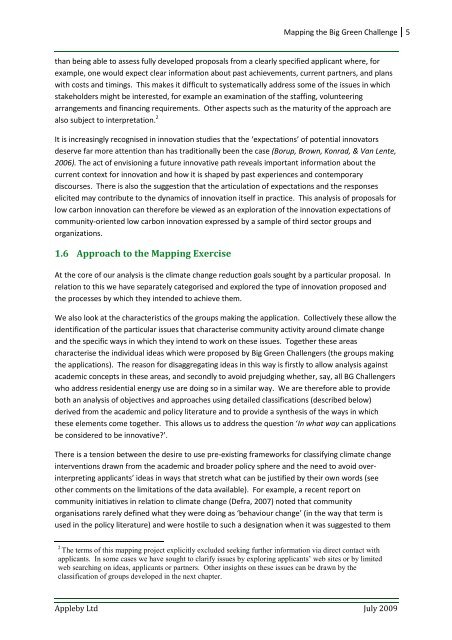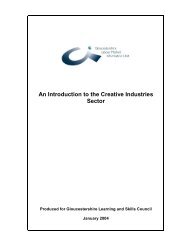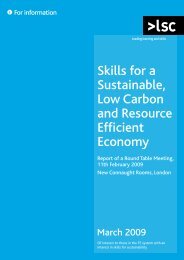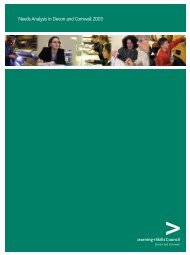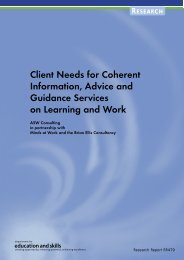Mapping the Big Green Challenge - The Skills & Learning ...
Mapping the Big Green Challenge - The Skills & Learning ...
Mapping the Big Green Challenge - The Skills & Learning ...
You also want an ePaper? Increase the reach of your titles
YUMPU automatically turns print PDFs into web optimized ePapers that Google loves.
<strong>Mapping</strong> <strong>the</strong> <strong>Big</strong> <strong>Green</strong> <strong>Challenge</strong> 5than being able to assess fully developed proposals from a clearly specified applicant where, forexample, one would expect clear information about past achievements, current partners, and planswith costs and timings. This makes it difficult to systematically address some of <strong>the</strong> issues in whichstakeholders might be interested, for example an examination of <strong>the</strong> staffing, volunteeringarrangements and financing requirements. O<strong>the</strong>r aspects such as <strong>the</strong> maturity of <strong>the</strong> approach arealso subject to interpretation. 2It is increasingly recognised in innovation studies that <strong>the</strong> ‘expectations’ of potential innovatorsdeserve far more attention than has traditionally been <strong>the</strong> case (Borup, Brown, Konrad, & Van Lente,2006). <strong>The</strong> act of envisioning a future innovative path reveals important information about <strong>the</strong>current context for innovation and how it is shaped by past experiences and contemporarydiscourses. <strong>The</strong>re is also <strong>the</strong> suggestion that <strong>the</strong> articulation of expectations and <strong>the</strong> responseselicited may contribute to <strong>the</strong> dynamics of innovation itself in practice. This analysis of proposals forlow carbon innovation can <strong>the</strong>refore be viewed as an exploration of <strong>the</strong> innovation expectations ofcommunity-oriented low carbon innovation expressed by a sample of third sector groups andorganizations.1.6 Approach to <strong>the</strong> <strong>Mapping</strong> ExerciseAt <strong>the</strong> core of our analysis is <strong>the</strong> climate change reduction goals sought by a particular proposal. Inrelation to this we have separately categorised and explored <strong>the</strong> type of innovation proposed and<strong>the</strong> processes by which <strong>the</strong>y intended to achieve <strong>the</strong>m.We also look at <strong>the</strong> characteristics of <strong>the</strong> groups making <strong>the</strong> application. Collectively <strong>the</strong>se allow <strong>the</strong>identification of <strong>the</strong> particular issues that characterise community activity around climate changeand <strong>the</strong> specific ways in which <strong>the</strong>y intend to work on <strong>the</strong>se issues. Toge<strong>the</strong>r <strong>the</strong>se areascharacterise <strong>the</strong> individual ideas which were proposed by <strong>Big</strong> <strong>Green</strong> <strong>Challenge</strong>rs (<strong>the</strong> groups making<strong>the</strong> applications). <strong>The</strong> reason for disaggregating ideas in this way is firstly to allow analysis againstacademic concepts in <strong>the</strong>se areas, and secondly to avoid prejudging whe<strong>the</strong>r, say, all BG <strong>Challenge</strong>rswho address residential energy use are doing so in a similar way. We are <strong>the</strong>refore able to provideboth an analysis of objectives and approaches using detailed classifications (described below)derived from <strong>the</strong> academic and policy literature and to provide a syn<strong>the</strong>sis of <strong>the</strong> ways in which<strong>the</strong>se elements come toge<strong>the</strong>r. This allows us to address <strong>the</strong> question ‘In what way can applicationsbe considered to be innovative?’.<strong>The</strong>re is a tension between <strong>the</strong> desire to use pre-existing frameworks for classifying climate changeinterventions drawn from <strong>the</strong> academic and broader policy sphere and <strong>the</strong> need to avoid overinterpretingapplicants’ ideas in ways that stretch what can be justified by <strong>the</strong>ir own words (seeo<strong>the</strong>r comments on <strong>the</strong> limitations of <strong>the</strong> data available). For example, a recent report oncommunity initiatives in relation to climate change (Defra, 2007) noted that communityorganisations rarely defined what <strong>the</strong>y were doing as ‘behaviour change’ (in <strong>the</strong> way that term isused in <strong>the</strong> policy literature) and were hostile to such a designation when it was suggested to <strong>the</strong>m2<strong>The</strong> terms of this mapping project explicitly excluded seeking fur<strong>the</strong>r information via direct contact withapplicants. In some cases we have sought to clarify issues by exploring applicants’ web sites or by limitedweb searching on ideas, applicants or partners. O<strong>the</strong>r insights on <strong>the</strong>se issues can be drawn by <strong>the</strong>classification of groups developed in <strong>the</strong> next chapter.Appleby Ltd July 2009


